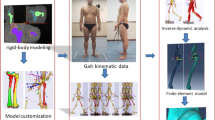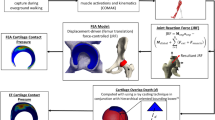Abstract
The hip joint plays an important role in the musculoskeletal system; however, current knowledge of the mechanics of the hip joint, especially with regard to the distribution of stress, remains limited. In experimental research, difficulties arise during reproduction of physiological conditions of daily activities and practicable measurement of locations inside the hip joint without violating the physiological environment. On the other hand, numerical approaches, such as finite element analysis, have become useful tools in the field of biomechanics. In finite element contact analysis of the hip joint, due to discretization of contact surfaces, computational instability might occur when the contact nodes move near the edges of the contact elements. In this study, to overcome this problem, a contact smoothing approach was introduced by applying Gregory patches. Contact analysis of the hip joint was then performed for three representative daily activities; i.e., walking, rising up from a chair and knee bending. The effectiveness of the adopted smoothing approach was verified by comparing the results with those obtained experimentally. The distribution and history of contact stress, which have heretofore been scarcely reported, were also obtained and the implications associated with osteoarthritis were discussed.












Similar content being viewed by others
References
Bergmann G, Deuretzbacher G, Heller M, Graichen F, Rohlmann A, Strauss J, Duda GN (2001) Hip contact forces and gait patterns from routine activities. J Biomech 34(7):859–871
Bissacotti JF, Ritter MA, Faris PM, Keating EM, Cates HE (1994) A new radiographic evaluation of primary osteoarthritis. Orthopedics 17(10):927–930
Brown TD, Shaw DT (1983) In vitro contact stress distributions in the natural human hip. J Biomech 16(6):373–384
Dalstra M, Huiskes R, Van Erning L (1995) Development and validation of a three-dimensional finite element model of the pelvic bone. ASME J Biomech Eng 117:272–278
Frankel VH, Burstein AH (1970) Orthopaedic Biomechanics, Lea & Febiger
Garcia JM, Doblare M, Seral B, Palanca D, Gracia L (2000) Three-dimensional finite element analysis of several internal and external pelvis fixations. ASME J Biomech Eng 122:516–522
Genda E (1997) Change of hip joint contact stress in daily life activity (in Japanese). Hip Joint 23:19–22
Genda E, Yamamoto S, Tanaka E (2003) Non-linear finite element analysis of hip joint contact stress (in Japanese). J Jpn Soc Clin Biomech 24:111–116
Greenwald AS, Haynes DW (1972) Weight-bearing areas in the human hip joint. J Bone Joint Surg Br 54(1):157–163
Greenwald AS, O’connor JJ (1971) The transmission of load through the human hip joint. J Biomech 4(6):507–528
Hodge WA, Carlson KL, Fijan RS, Burgess RG, Riley PO, Harris WH, Mann RW (1989) Contact pressures from an instrumented hip endoprosthesis. J Bone Joint Surg Am 71(9):1378–1386
Hodge WA, Fijan RS, Carlson KL, Burgess RG, Harris WH, Mann RW (1986) Contact pressures in the human hip joint measured in vivo. Proc Nat Acad Sci 83(9):2879–2883
Ipavec M, Brand RA, Pedersen RD, Mavcic B, Kralj-iqlic V, Iqlic A (1999) Mathematical modelling of stress in the hip during gait. J Biomech 32(11):1229–1235
Johnson KL (1985) Contact Mechanics. Cambridge University Press, Cambridge
Kumagai M, Kim YH, Inoue N, Genda E, Hua K, Liong BTL, Koo T, Chao EYS (2003) 3-D dynamic hip contact pressure distribution in daily activities. In: 2003 Summer Bioengineering Conference, Key Biscayne, US, pp 53–54
Laursen TA (2002) Computational contact and impact mechanics. Springer, Berlin Heidelberg New York
Macirowski TJ, Tepic S, Mann RW (1994) Cartilage stresses in the human hip joint. ASME J Biomech Eng 116:10–18
Mavcic B, Pompe B, Antolic V, Daniel M, Iqlic A, Kralj-Iqlic V (2002) Mathematical estimation of stress distribution in normal and dysplastic human hips. J Orthop Res 20(5):1025–1030
Michaeli DA, Murphy SB, HIPP JA (1997) Comparison of predicted and measured contact pressures in normal and dysplastic hips. Med Eng Phys 19(2):180–186
Park S, Hung CT, Ateshian GA (2004) Mechanical response of bovine articular cartilage under dynamic unconfined compression loading at physiological stress levels. Osteoarthr Cartil 12(1):65–73
Park S, Krebs DE, Mann RW (1999) Hip muscle co-contraction: evidence from concurrent in vivo pressure measurement and force estimation. Gait Posture 10(3):211–222
Puso MA, Laursen TA (2002) A 3D contact smoothing method using Gregory patches. Int J Numer Method Eng 54:1161–1194
Simonian PT, Routt MLC, Harrington RM, Moya KA, Tencer AF (1994) Biomechanical simulation of the anteroposterior compression injury of the pelvis. Clin Orthop Relat Res 309:245–256
Stadler M, Holzapfel GA, Korelc J (2003) C-n continuous modelling of smooth contact surfaces using NURBS and application to 2D problems. Int J Numer Method Eng 57:2177–2203
Author information
Authors and Affiliations
Corresponding author
Rights and permissions
About this article
Cite this article
Bachtar, F., Chen, X. & Hisada, T. Finite element contact analysis of the hip joint. Med Bio Eng Comput 44, 643–651 (2006). https://doi.org/10.1007/s11517-006-0074-9
Received:
Accepted:
Published:
Issue Date:
DOI: https://doi.org/10.1007/s11517-006-0074-9




